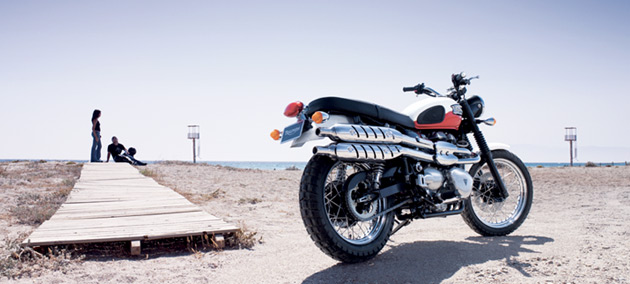Triumph Scrambler channels Steve McQueen
But this bike is best as urban commuter
Friday, October 6, 2006

First question: What, if anything, has Triumph Motorcycles -- reconstituted after a devastating factory fire in 2002 -- paid the estate of actor Steve McQueen?
The iconic leverage of the new Triumph Scrambler pivots almost entirely on McQueen, who rode a Triumph Enduro in the 1971 documentary "On Any Sunday" and a Triumph in the World War II thriller "The Great Escape" (stunt rider Bud Ekins doubled for McQueen in the famous jump scene, and the Triumph doubled for a BMW, lore has it).
For guys who really want to channel Steve, the Triumph Scrambler obliges. You can even order an optional "278" number board, McQueen's entry when he raced in the 1964 International Six-Day Trials in East Germany. How bad do you have to have McQueen Fever to know that?
The Scrambler is the latest of four Modern Classics bikes from Triumph, and it might as well conjure 1960s California with a Ouija board: the two-tone paint, chrome escutcheons and rubber knee grips on the tank, bench seat with white piping, exhaust pipes intertwined like crossed fingers (though back in the day, the pipes were on the left side). Much like the genuine Bonneville Scramblers, it has gaitered front shocks, wire wheels, wide flat handlebars and relatively knobby tires (Bridgestone Trail Wings).
This in no way should lead you to believe it is a true dual-sport bike, a la Ducati Multistrada. As soon as the tires touch gravel, form and function part company. The Scrambler -- based largely on the Bonneville T100 streeter -- has a wet weight of about 500 pounds and tires that are not much more trail-able than your average street tire. Also, the historically faithful rear coil-overs don't surrender much suspension travel, so the Scrambler rear starts to jackhammer at moderate speeds on chuck-holed fire roads.
Yes, it can be taken off pavement -- the Scrambler suspension has been raised 2 inches over the Bonneville, for improved ground clearance -- but I didn't expect it to be quite so much of a, um, scramble.
This is essentially a road-purposed bike -- more specifically, an urban commuter. Between the gloss-black frame rails is Triumph's 865-cc, dual-overhead cam parallel twin -- the same mill as in the nostalgia-themed Thruxston and Bonnie T100.
However, the engine has been slightly detuned for more low-end torque (51 foot-pounds at 5,000 rpm) at the expense of horsepower (54 hp at 7,000). The bike steps off the line nicely and can clear four-wheeled traffic without much trouble. But it strains a bit at higher rpm and quasi-legal interstate speeds. The rider strains a bit, too. The lack of a windscreen, combined with the very upright riding position, makes for a face-first buffeting that would shame a North Sea gale.
If you push the Scrambler, it does have some reserves of street performance. It drops into a corner with finesse -- all that extra leverage from the big handlebars -- and holds a line well. It has good lean angles and makes side-to-side transitions with less drama than Sunday morning C-SPAN. The handling is seamless and reliable, with low-speed agility and parking-deck maneuverability.
The bike is carbureted, not fuel-injected, so riders will have to pull the choke and let the engine warm up before it falls into a shuffling chuff. With a fuel economy in the neighborhood of 50 mpg, the dead-simple Scrambler makes an excellent commuting bike, while offering a hugely romantic presence on the street.
Expensive? Rather. Nobody said being Steve was going to be cheap.
2006 Triumph 900 Scrambler Base price: $7,999 Powertrain: 865-cc, DOHC, four-stroke parallel twin, air-cooled with carburetors; five-speed Horsepower: 54 hp at 7,000 rpm orque: 51 foot-pounds at 5,000 rpm Wheelbase: 59 inches Seat height: 32.5 inches Weight: 451 pounds (dry) Final thoughts: Peaceful, easy wheeling.